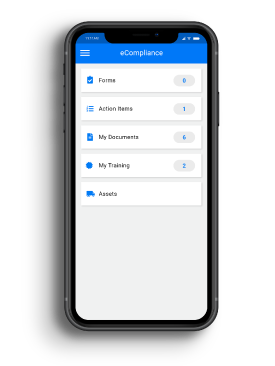
Share this Post
UPDATED
September 20, 2022
READ TIME
4 minutes
WRITTEN BY
![]() Dina Adlouni
Dina Adlouni
Dina is the resident Content Writer at EcoOnline North America . When she’s not writing about health and safety, you’ll find her enjoying a cup of tea while watching her favorite sitcom.
What are the leading indicators in safety?
In the world of health and safety, it’s no secret that tracking leading indicators is a much more effective practice for managing a world class safety program than focusing entirely on lagging indicators.
But first, let’s start with the basics: what are leading indicators? A leading indicator is a form of predictive metric used to measure safety program performance. These numbers help keep you proactive, by allowing you to focus on key areas which may need improvement to prevent an incident from occurring.
Examples of safety leading indicators include:
- Employee training courses completed
- Safety meetings conducted
- Inspections completed
- Behavior-based safety observations
- Corrective action closure rate
Leading vs. Lagging Indicators
Leading and lagging indicators are both metrics used in safety, however it could be argued that leading indicators are much more effective to improve your safety program. Lagging indicators are those which are based on incidents or accidents which have already occurred.
Examples include:
- Days Away Restricted or Transferred (DART)
- Lost Time Injury Rate (LTIR)
- Total Recordable Incident Rate (TRIR)
- Experience modification rate (EMR)
- OSHA recordables
While it is important to analyze lagging indicators like those mentioned above, they must also be evaluated with leading indicators to help establish gaps and deficiencies to improve within your safety program.
How Tracking Leading Indicators Can Improve Business
Identifying leading indicators allows your company to take a proactive approach to safety, catching hazards and assigning corrective actions so you can prevent incidents from occurring. By implementing a better way to identify workplace hazards you gain the opportunity to help executives make business decisions that improve productivity.
Tracking leading indicators provides you with the data you need to make informed decisions that improve your business. Here’s how:
1. Identification of Gaps in Employee Training
Employee training is one of the cornerstones of any safety management system. There are a multitude of training approaches such as on-the-job training, classroom training, on-line training and so on. It is essential for you to be able to plan for this training and be able to track it to ensure compliance with legislation and your own internal safety management system.
Poorly trained employees can be disastrous for productivity. When an employee doesn’t know how to safely do their job, it not only increases the amount of time it takes the employee to complete their duties, but it also increases the likelihood of incidents resulting in time losses, incidents, and injuries. This is why tracking the number of training courses completed by employees is critical. When you track this leading indicator, along with observable hazards in the workplace, you can identify patterns of unsafe behaviors. This can help indicate that more employee training is required in certain areas.
2. Making Effective Purchasing Decisions
Leading indicators can help identify areas of concern, through scheduled and ad hoc inspections, action items from incident reports and hazard assessments and so on. This will help prioritize either preventative or predictive maintenance, or the decision to upgrade or replace equipment.
For instance, Pieper Electric (an EcoOnline customer since 2017), was able to discover through their BBSO reporting that a specific piece of equipment was being misused. Based on this leading indicator along with lagging indicators such as injuries related to this piece of equipment, they were to purchase a different tool. This helped them reduce their instances of unsafe equipment usage from 25 instances bi-monthly to just once.
3. Uncovering the Need for Procedure Changes
In addition to being able to plan and efficiently track your training requirements or identify existing and potential equipment maintenance and replacement requirements, leading indicators can also help you identify procedures that may require updating or revising. This is done through tracking action items from BBSOs, inspection reports, hazard assessments, incident action items and audit review items.
Another EcoOnline customer, Mobilinx, was able to find a correlation between inspection deficiencies and coaching trends using our robust solution. More hidden gaps were uncovered when workers were in a more relaxed setting and felt a sense of psychological safety. With this insight, they were able to conduct more coaching opportunities within their coaching program to instigate dialogue. This helped them create dashboards within EcoOnline to identify real-time trends on leading indicators that they could compare to lagging indicators observed.
“We’re seeing a relation between the two and early data is showing us that if we’re talking about the right things, we can drive down deficiencies on the jobsite. This transparency and real-time reporting allows us to mitigate situations promptly. I believe leveraging the power of leading indicators has been a tremendous reason for our early success,” said Stewart Day, the Health and Safety Director. Due to this insight, the Mobilinx team has been able to assign 700 action items with a 90% close out rate.
How can EcoOnline help?
At the end of the day, tracking leading indicators helps improve business decisions because it provides you with real actionable data that’s necessary to spot risks before they result in time loss and incidents. Leading indicators not only expose early signs of on-site hazards your workers face but also give upper management the data they need to make informed decisions about safety risk. With leading indicators, you can easily spot trends that show the areas of your business that require revisions or improvements.
As mentioned above, the EcoOnline suite of solutions can help you track leading indicators to create a safer work environment. Explore our extensive eLearning course catalogue, training management and behavior-based safety observation capabilities, and much more! Curious to find out more? Speak to an EcoOnline representative today.
Learn How You Can Get EcoOnline
Complete this form and one of our safety experts will be in touch.

